“Bending the Arc,” the current exhibit at the Annex Gallery is a must see for anyone who is genuinely interested in the social history of our country and who has at heart a just, equal and compassionate America. The exhibit features work by two artists who both, through their rich, personal and relevant work, want to make sure that history is not forgotten, and who, by the same token, try to open doors for awareness, understanding, dialogue, unity and hope. Both artists use their art as their voice and as their activist message for a change toward a better world.
I.
The exhibit consists of a composite of thirty-seven 3D mixed media artworks/installations and three paintings by VL Cox, an artist born in 1962 in Louisiana, raised in Arkansas, and who currently lives in New York; and eleven large oil paintings, three of them part of a triptych, by artist Stephen Mangum, born in 1954 in Mississippi, and currently living in San Francisco. Both artists are quite accomplished and use different media and styles to create skillful and impactful artworks, refined and pleasing in their esthetics, and rich and powerful in their content. Their works address racism and discrimination in our history: Mangum’s as they relate to a time of his childhood (1955-1968) that coincided with the civil rights era, and Cox’s as they relate to the same period, but also as they extend to our current history, particularly regarding human rights.
Both artists use a similar approach of incorporating real historic elements in their artworks. The background of each of Mangum’s large canvasses consists of a painted image reproducing a real photograph that documents a specific historic episode of discrimination that occurred during his childhood, and that image was taken at the time by various photojournalists (Bill Hudson, Matt Herron, Charles Moore…). Cox resorts, in the construction of her pieces, to authentic parts and materials recovered from period churches and houses, vintage metal signs and period garments and fabrics… all reflective of the time she addresses. Her intent is to connect the viewer directly, through their use, to the past.
“They connect us, and their familiar appearance, feel, and even smell create a primal tactile sensory experience that awakens our memories,” she says. “They remind us of the lessons we have forgotten, and once again need to learn…”
The works occupy the two large spaces and adjacent office of the Annex Gallery. Mangum’s paintings, with their imposing size ranging from 6 to12 feet, hang on the walls, interspersed with Cox’s sculptures, installations and paintings, spread throughout the gallery floor and on its walls. All the pieces, like on a stage, refer to each other, interact with each other, enrich their respective messages, engulfing the visitors in a visual, sensory and thought-provoking whirl and inviting them to a dialogue about our country and its history.
II.
Mangum’s paintings are part of a series appropriately titled “Illusions of my Childhood”. Each of them consists of a large canvas whose background is entirely covered by the image of a particular reprehensible event that took place then.The background image is painted in white, black, and grey and imposes itself by its size, its content, and its subdued tones as a persistent present reminder of the dark event that had happened.
It is superimposed in its center by one or two lively figures of a child, enjoying a basic pleasurable activity such as eating an ice cream or a candy, drinking a soda, or licking a lollipop… Each child depicted is one of Mangum’s grandkids. Mangum painted them in bright colors but yet transparent enough to allow the ominous grey image of the background to come through. He wanted to connect them (and indirectly himself) to a beautiful, happy, innocent, and hopeful life, yet to one that is not oblivious of what had happened in the past, but on the contrary, who has learned from it and who is making sure that it will not be repeated.
In his painting “Freedom Summer,” #4 of the series, Mangum reflects on the brutal killing, in June 1964, of James Chaney, Andrew Goodman, and Michael Schwerner, at the hand of Klansmen, while investigating the fire-bombing of Mount Zion Methodist Church in Neshoba County, Mississippi. The background image represents their portrait adjacent to the written call by the FBI seeking information about their disappearance.

“Masquerade,” #10 of the series, represents a march of Klansmen parading proudly in full daylight, August 1964, in Salisbury, North Carolina. In the front row is an apparently pregnant woman, a reference to the mother of Bob Jones, then the Grand Dragon of the North Carolina Ku Klux Klan. Jones frequently boasted about his mother’s participation in a Klan parade while she was seven months pregnant with him.
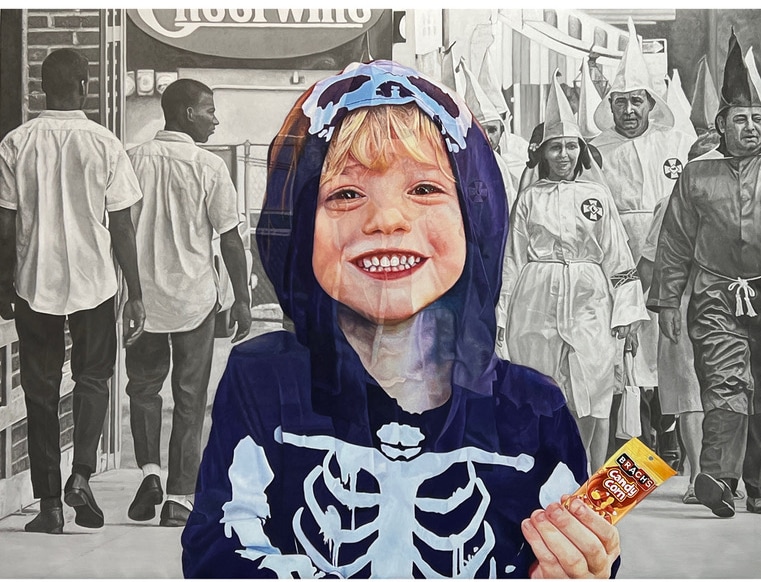
In #1, 2, 3 and 5 of the series, Mangum represents portraits of seminal figures of the civil rights period, who were killed hatefully by white supremacists, due to their race and/or human rights advocacy. In #1, 2 and 3, Emmet Till, abducted, tortured and lynched at age 14 just for being black; Medgar Evers, American Civil Rights activist, killed due to both the color of his skin and his beliefs, by a white man later acquitted by an all-white jury; Martin Luther King, Jr, assassinated in Memphis in 1968. And in #5, Ruben Stacey, a black laborer accused wrongly of having drawn a knife on a white woman, kidnapped by a mob of white men, hung from a pine tree, and repeatedly shot in his hanging body.
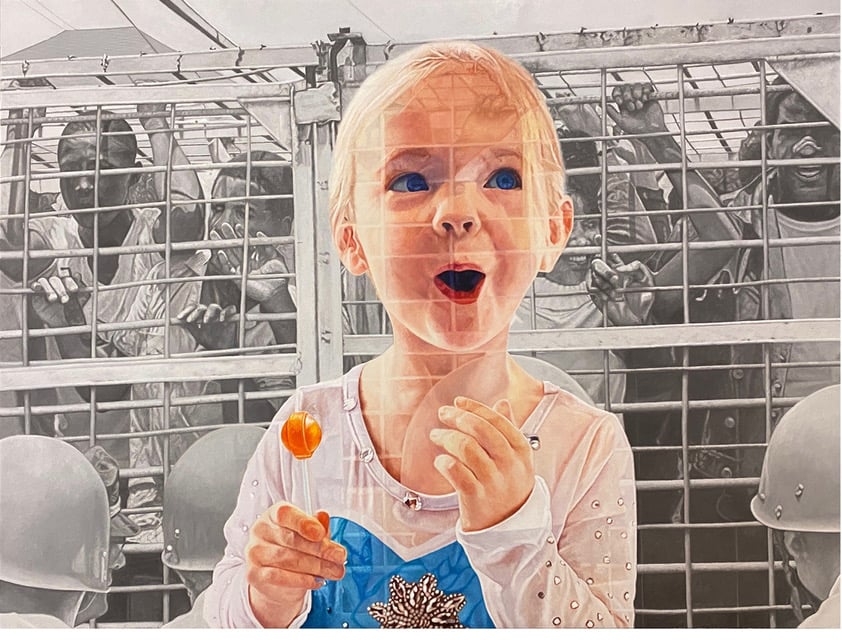
In other paintings, Mangum depicts blacks being arrested and attacked for protesting against segregation and inequality. #9 of the series, titled “Pageantry,” shows in the background an image of black individuals held captive in cages. They are the 700+ protesters who, in June 1965, led by John Lewis, were demonstrating against the Mississippi legislature’s opposition to the Voting Rights Act. They were arrested by the police and held for over two weeks under brutal conditions in a fairground’s animal sheds. And #6, 8 and 11 depict images of the Children’s March of May 1963 in Alabama when 1000 black students marched peacefully in protest against segregation. They were sprayed with water cannons, attacked by police dogs, arrested, and jailed under the orders of Bull Cannon, then Birmingham’s Commissioner of Safety.
III.
Like Mangum, Cox also addresses in her work events of the Civil Rights era, referring in particular to the Ku Klux Klan and to John Lewis. Like all her other works, she constructs them with authentic historic elements of the time, wanting the past and its history to be ever present, hoping that it will be “…eliciting diverse dialogue and cultivating conversation about community civil rights and social issues addressing our society today.

Her mixed media installation “Soiled” includes a blood-stained Klan robe, most likely used in the “Red Summer” of 1919; a vintage metal signage about “whiting” and color removal; and a rope from an old bell tower church. The installation and its components are meant to show the high level of racial hatred embodied by the Ku Klux Klan.

In “White Bread” she reflects on the children “Klan Camp” held every summer at the National Ku Klux Klan headquarters in Harrison, Arkansas. The teddy bear, held and controlled by a Klansman, is painted facing backwards, alluding to children’s loss of innocence as a result of their early indoctrination into discrimination and hatred. The statement written on the period screen door praises the Colonial “White Bread.”
In “Good Trouble” one of the rare paintings included in her show, Cox sheds a positive note regarding heroes of that era. She represents a body size painting of Civil Rights Icon John Lewis, standing tall in front of and surrounded by the American flag. She added actual soil from the Edmund Pettus Bridge in Selma, Alabama, around the bottom of his shoes. Cox wants to remind us of those who during that dark period stood and fought for equality and justice; also to solicit us to become, all like them, “good troublemakers.”

In “Cracker Crumbs” she responds to prejudicial judgments (“crumbs”), still prevalent in our country today, regarding blacks in general. Usually built on underlying mistrust, lies and deceit, they demean people of color and keep them under white supremacist control. The mixed media installation consists of an antique bank and an antique gum ball machine. When a lever is pressed on the back of the shoulder of the black figure, his arm raises to his mouth and the eyes and ears move as if being forced to ingest the “cracker”.
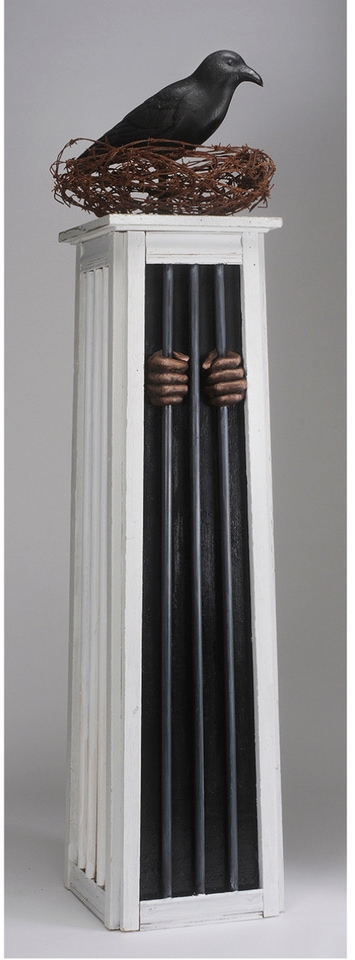
“Jim” makes a statement about the disproportionate and often unwarranted incarceration of black Americans. It displays a white column taken from an old craftsman style front porch, porch where generally in the South, a lot of time is spent relaxing, watching the world go by. Unfortunately, many Blacks cannot enjoy this simple luxury, instead frequently unjustly forced into lucrative and politically controlled prisons. The elegantly constructed sculpture shows black hands behind obstructive bars inserted in the front of the column. A vintage Crow decoy is standing in the center of a nest of rusted barbed wire, on top of the column, a reminder of Jim Crow.
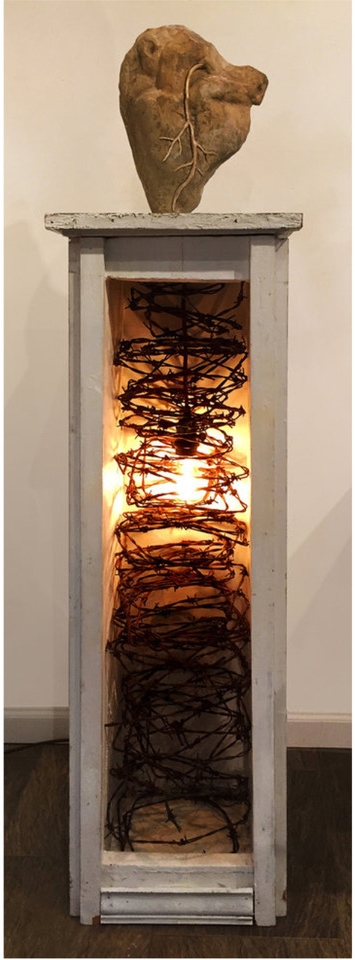
“Pillar” responds to Cox’s hope that our heart ceases to be of stone, that we open it to others, recover our humanity, and get rid of our prejudices and discriminations. The installation shows a heart carved in stone, sitting on top of an antique craftsman style porch column, symbolizing the foundations and lessons of the South. Inside the column is old rusted barbed wire that came from a property blessed by a church, and in its middle, a light representing hope.
Many of Cox’s pieces included in the show are part of a series titled “End Hate” Project that she launched in 2015. The series consists of a narrative body of work that looks at our history of past and present discrimination, gender inequality, human rights abuses. It shows us where we’ve been before and where it is imperative we do not go again.

A major piece of this series is the “End Hate Doors,” an installation of segregation era doors, each door of a different color and with a different divisive label (Whites only, Colored only, LGBT only, Immigrant only, etc.). The installation was created in response to HB1228, a Religious Freedom discriminatory bill, which would have brought back hatred and repression to Arkansas. The doors were placed twice on the steps of the Arkansas State Capitol, and due to the resulting public pressure they elicited, the bill was thankfully defeated. They were then displayed twice at the base of the Lincoln Memorial in Washington, D.C.
“Stained,” another mixed media piece of the series, was created with several hundred pages of the Bible, each made into a tea bag with real tea leaves put inside. The tea bags were then arranged into an American flag configuration. It was Cox’s statement about the ‘Tea Party’ and the damage it has caused the country when it took messages of the Bible out of context and used them to harm others.
Cox’s statement against gun violence and in favor of gun regulation is clearly and loudly expressed in her bone assemblage “Cease.” She used authentic medical human bones to compose a skeletal ‘assault rifle’ and thus to call attention to the enormous human toll guns inflict on our country.
Not surprisingly, many of Cox’s pieces address gender issues, in particular women’s rights, their freedom, and the important role they can play in society.

“The Crucifixion of Mary,” a mixed media sculpture, shows the body of a “crucified” woman partly wrapped by an American flag. The flag covers entirely her face and is interlaced between her legs, invading her intimate parts. The piece alludes to women being silenced in our society, hidden, not given access to their free self-expression, their body owned and controlled by men and by politicians, property of the State who can decide of their fate. This piece, quite relevant in view of the recent overturn of Roe v. Wade, speaks as well to the sexual abuse women are subjected to, a subject Cox also illustrated eloquently in “Hands- Off”. In this mixed media installation, an authentic steel woman dress form has two prominent red box gloves attached to it. The gloves seem to caution and alert the potential abuser regarding women’s strength and their protective right to their own body.
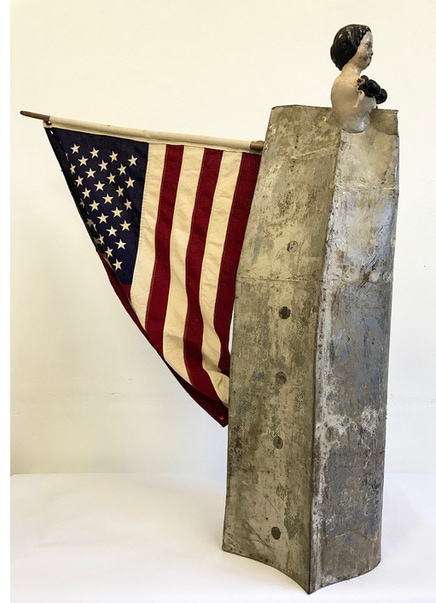
The theme of women’s strength and unity and of their independent and powerful wisdom and courage is beautifully addressed in “USS Defiance” a mixed media sculptural installation in which a woman represented by a doll’s bust and head seems to be sailing a boat with the American flag as its mast and sail. Cox wanted her to represent all the women now stepping forward in unity to take their place in history, fighting repression and injustice, for the sake of a just and equal country.
Many of the works included in the show also address various aspects of our politics today. Cox is particularly sensitive to the role religion plays in our country and how it is used and abused by politicians to serve their own interest and subjugate poor ignorant followers.


VL Cox: Ready, Aim, Fire and Brimstone, mixed media
“Veneration” throws a statue of Jesus off its altar base and replaces it with 30 pieces of silver, symbols of betrayal, on which stands proudly a rigid iron Jim Crow. It is Cox’s staunching statement about the hypocrisy of politics and politicians in our country, where Jesus has been dethroned and quickly replaced by money and lies.
“Ready, Aim, Fire and Brimstone” consists of an original vintage Bible cover mounted on the end of a 1939 Coca Cola box cooler. It alludes to how easily and carelessly the Bible is being used nowadays at every occasion, emptied of its content and meaning, just to achieve the goals of “false prophets” and establish their power.
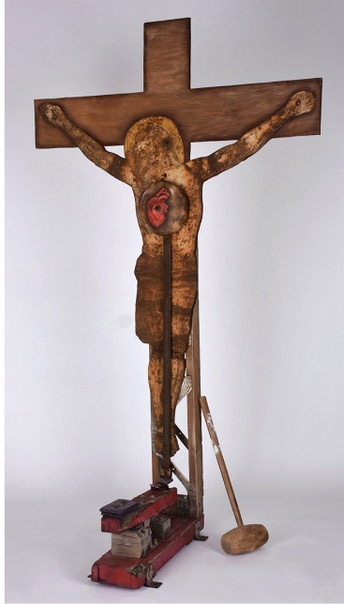
Cox reflects also on gullible vulnerable individuals manipulated by politicians who use empty and false religious promises to entice them. Blinded, they cease to see the truth, and follow obediently, falling in the trap. She visualizes that situation in “The Mark,” an installation that represents a Crucifix, alluding to religion, also a wooden mallet with chalk handprints on it. The chalk handprints are reminder of when dishonest carnival game operators would entice people to keep playing their “rigged” game and would “mark” them by patting their back with a hand that had chalk on it, so they could be recognized by others and become also their prey. “The Mark” is in thinking of political and religious leaders who use such tricks to trivialize the Christian Faith to divide, marginalize, mislead, and take advantage of people for their own gains.
Other works of Cox included in the show deal with additional justice and human rights topics such as LGBTQ and homophobia, voter suppression, patriarchy, violence and war, etc. In fact the majority of her works address some aspects of social injustice in our country. They underline her strong desire to bring their negative to the surface in order to generate a dialogue about them, and thus hopeful, create conditions for positive alternatives toward change and a better America.
In her poignant mixed media “America,” Cox addresses her own pain face to all the troubles our country has been going through and has experienced recently: pandemic, social and political unrest, wildfires, tornadoes and earthquakes… She expresses it visually using an imposing chair, upholstered with the American flag, but with the entirety of its seat transpierced by long pointed thorns. She is, however, quick to respond, with hope, with 2 additional works that stress the beauty and the positive resilience of our country. In “Columbia,” she celebrates the beauty and richness of diversity that one encounters in the United States, for her one of its hopeful characteristics. She represents it by a steel antique female dress form with a vintage American Flag hand-sewn inside it. The tall resulting form imposes itself by its strength, pride and majesty. And in “Old Glory,” she comments on the strength and resilience of America, who will continue to be great despite all adversities. The mixed media sculpture that embodies an American flag consists of an old piece of painted blue vintage steel, knocked and banged around, but still firm and strong. This metal piece represents the starry part of the flag. Attached to it is a striped white and red cloth, representing the other part.
“Even though we take a pounding, regardless of our stance or differences, I still believe that we are Americans, our country is strong, and freedom, equality and justice FOR ALL will prevail,” affirms Cox.
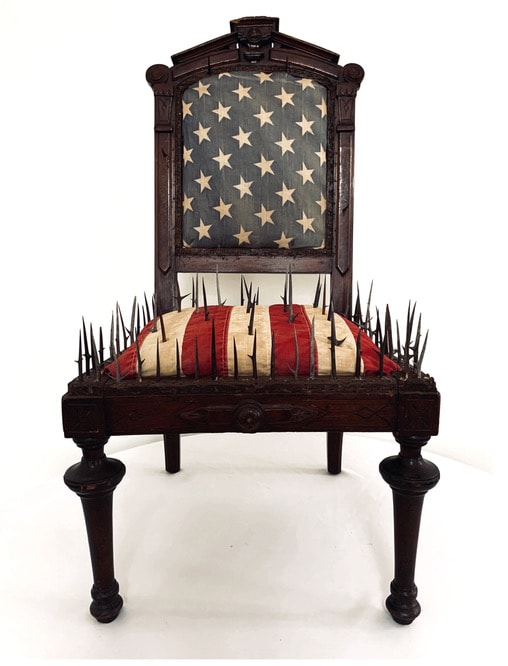
IV.
“Bending the Arc” is a sad but also a hopeful show. Both artists, Stephen Mangum and VL Cox, use their art to connect us to our history, pointing to what went, and in some instances still going, wrong; but also to what can and needs to be changed; and to the role each of us can play in this respect. It is an important show to see. And one should be thankful to both artists for sharing their heart, their beliefs and their hope, through their art, with us; and for inviting us, at the same occasion, to partake with them in the molding of a better future, a better America, and a better world.